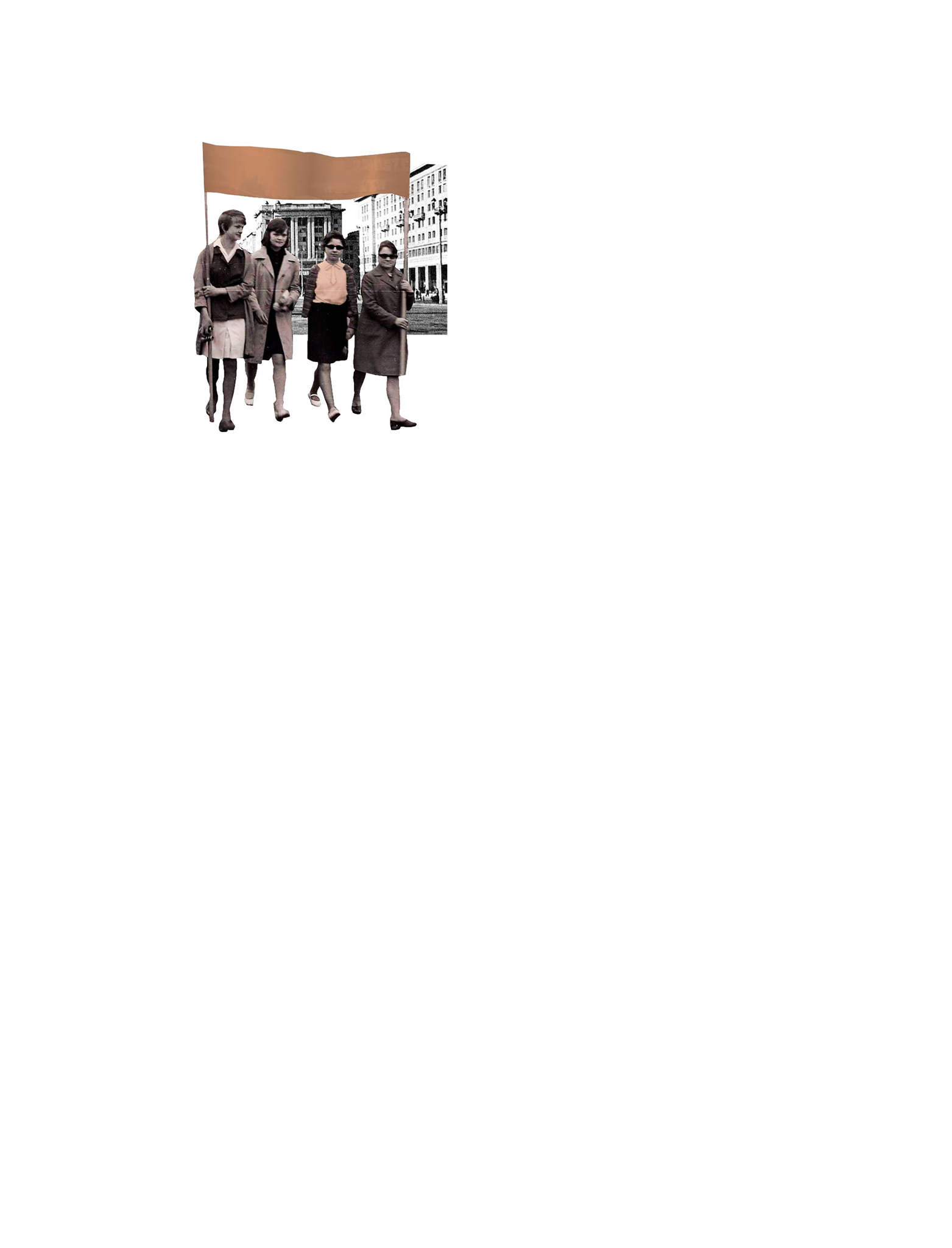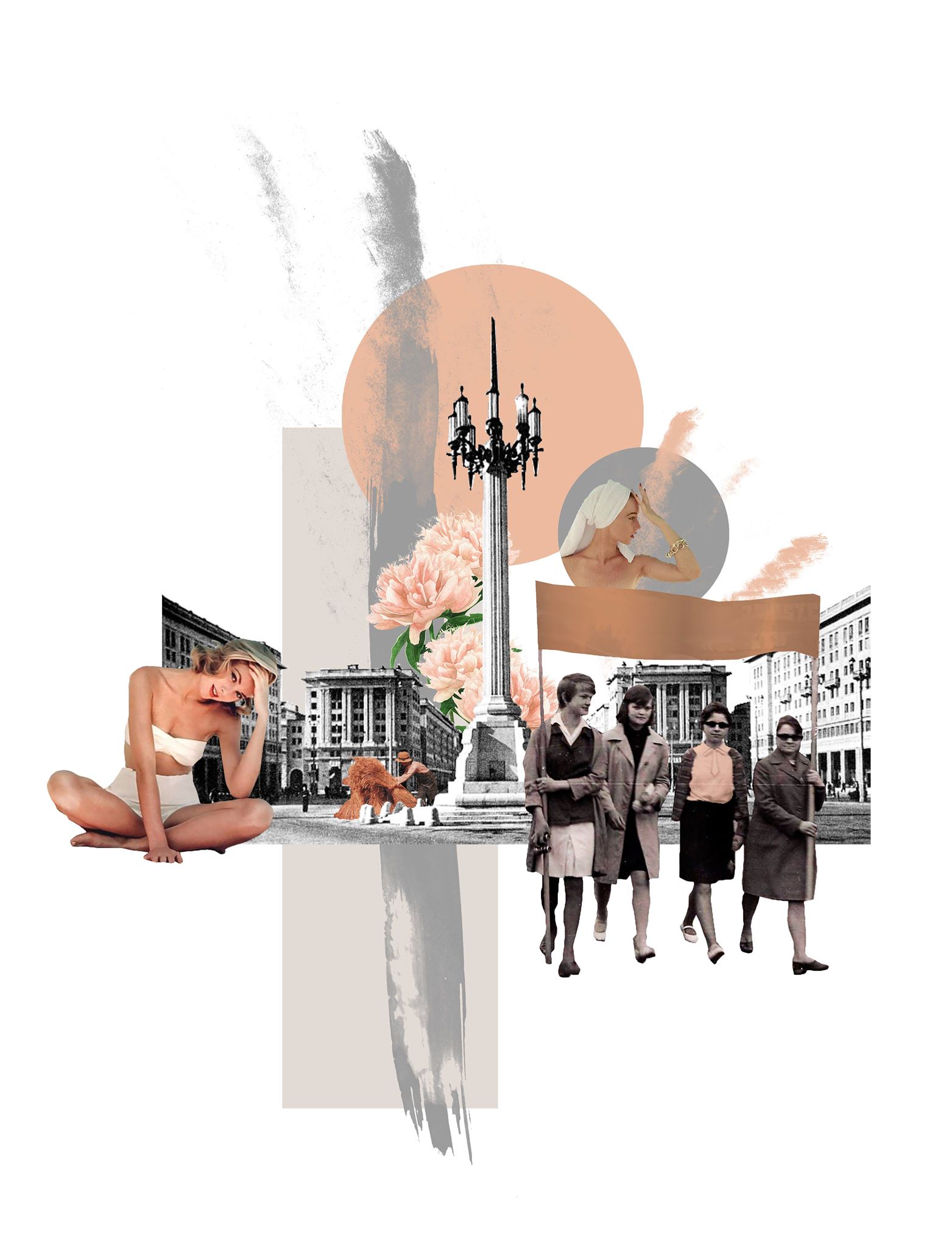
text and graphics: Katarzyna Zabielska,
student at the Faculty of Architecture, Cracow University of Technology
consultation:
dr inż. arch. SARP IARP Marta A. Urbańska
oryginal version of the text : PL
translation to english: kreatura team
reading time: around 12 min
// Style imposed. Not even a style, rather ideology. The ideology of oppression, the Soviet ideology, the idea of Stalin himself. Bad, ugly and quite not ours ... and that would be it.
Socialist realism doesn’t appear in student art books and on history lessons only few teachers manage to actually reach the material about the Second World War. Socialist realism resounds in our minds with the slogans of propaganda, maybe even more vividly than the past days. Collective consciousness has already been chewed by modernism: maybe ugly, but Corbusier at least was pointing to something. And blocks... we're all from the blocks! But yet we still have a problem with socialist realism.
Nevertheless, this style has been accepted in Poland. It spreaded, pushed… at least left his mark. And even after 1989, nobody dared to demolish it, paint it or strip it of decorativeness. The opposite. Nowa Huta is more and more often associated with bohemian art; Marszałkowska Residential District is one of the most desirable addresses in Warsaw; Plac Zbawiciela became legendary and rooted in both the consciousness and cultural environment of Warsaw inhabitants.
It was supposed to be different
The vision of rebuilding the capital city of Warsaw has awakened the minds of architects during the occupation. In 1940, the Architectural and Urban Planning Office was created, initially led by Szymon Syrkus (later also joined by Helena Syrkus and Roman Piotrowski). The Office dealt with the development of technical documentation and reconstruction of housing estates in Rakowiec and Koło. At the same time, works on the new urban planning of Warsaw were also carried out. The workshop was characterized by a total approach to design, rooted in the beliefs of the Praesens group and left-wing social views. Hence, the main focus of interest was the study of residential and industrial districts. However, much greater impact on the post-war reconstruction of Warsaw was in hands of the Commission of Urban Experts and its opinion on the plans of the city developed in the Municipal Board. The Commission valued four categories of streets and squares, defined local conditions and regulations for the historic Stanisławowska district; it also created a list of buildings and complexes that demanded special care.
1. E. Perlińska – Kobierzyńska, Warszawa, miasto do przebudowy, [w:] Spór o odbudowę Warszawy. Od gruzów do reprywatyzacji, red. T. Fudala, Museum of Modern Art in Warsaw, Warzawa 2016, p. 66–78
2. A. Kędziorek, City Macieja Nowickiego, [w:] Spór o odbudowę Warszawy. Od gruzów do reprywatyzacji, red. T. Fudala, Museum of Modern Art in Warsaw, Warszawa 2016, p. 162–167,
based on dr Marta Anna Urbańska's the doctoral dissertation Maciej Nowicki - humanista i wizjoner architektury; osobowość twórcza na tle epoki, Cracow University of Technology, Kraków 1999 and materials and illustriations by dr M. A. Urbańska
3. M. Obarska, MDM – między utopią a codziennością, „Egros”, Warszawa 2010, str. 81
Having valued the architecture of Stanislaw August Poniatowski and the Kingdom of Poland era over chaotic heritage from the times of partitions, it was planned to transform the space by, for example, demolishing quarters or introducing green belts. The opinion contained demands from the Athens Charter, such as functional zoning of the city or striving to improve the hygienic conditions of the residents. The reconstruction projects of the capital, being prepared for five years, changed dramatically after the Warsaw Uprising and the subsequent German policy to demolish the surviving buildings. In the face of enormous damage, there appeared some voices about not just rebuilding but almost redesigning the whole city. On January 22, 1945, the ruling president of Warsaw Marian Spychalski (architect and urbanist) brought to life the Office for the Organization of the Reconstruction of Warsaw under the supervision of Jan Zachwatowicz. The activities were continued by the later well-known Office for Reconstruction of the Capital. Under the chairmanship of Zygmunt Skibniewski, a sketch for the central districts is created. It’s based on segregation of functions, free planning among greenery and significant communication arteries. It contains pre-war projects of the City Planning Department and some occupation projects and plans of Maciej Nowicki. Although the work is of a sketchy nature and based on its assumptions, decisions about the demolition of existing buildings following this project are often made.1 Worth mentioning is the design by Nowicki's office. It included the development of the downtown part of Warsaw, the so-called city. The project consisted of the combination of low-rise four-story buildings of a quiet, even classical architectural expression, addressed to pedestrians, and fourteen-story buildings - creating the metropolitan silhouette of the city, visible from a distance. Nowicki combined the features of modernism (geometrization, repeatability of teams, consistent architectural expression, modularity) with the character of typical downtown buildings.2 In 1948, in the competition for the city center, the pure functionalist project was awarded. Skyscrapers on the circular plan, based on pilotis, seemed to detach from the ground and float above the lower, thoroughly modernist buildings. Soon the project gets criticized, it’s said to resemble a trash can or a pipe from the stove.3
4. E. Kal, Aby „Lud Wszedł do śródmieścia” Ludowość i inne paradoksy metody realizmu socjalistycznego w architekturze, [w:] Pod dyktando ideologii. Studia z dziejów architektury i urbanistyki w Polsce Ludowej, red. Paweł Knap, Szczecin 2013,p. 26
5. A. Sumorok, Zaprojektować socrealizm? W obronę architektury, [w:] quarterly „Herito” nr 29, p. 74
6. B. Bierut, Plan sześcioletni Odbudowy Warszawy, Warsaw 1950, p. 20, [cyt. za:] M. Obarska, MDM – między utopią a codziennością, dz. cyt., p. 58, translation: kreatura team
Let it become common
Soon the great urban planning finds some common ground with politics. Introduced October 26, 1945, Decree on ownership and use of land in the area of the Capital City of Warsaw establishes all the lands located within the borders of the pre-war capital city as the property of the commune. The so-called Bierut Decree was supposed to be a tool for urban development, enabling to centrally control rebuilding of the capital. Despite the fact that it was only meant to concern the ownership of mentioned lands, in practice, robbed the owners also from the buildings occupying them. It all happened without compensation. The further application, after the transformation in 1989, for the return of once taken lots and real estates, led to a huge debt of the city, unclear and sometimes illegal claims from pre-war owners or even forced eviction of the current tenants.
The next field on which the state declares its domination is culture. On June 20-21, 1949, during the ongoing congress of the party architects in the Central Committee of the USSR, socialist realism was introduced.4
// Architecture is to become the medium of ideology; the construction practice is being criticized, and trends such as modernism, constructivism and functionalism are considered ideologically foreign.
The doctrine originating from the USSR, in its homeland becomes clearly defined. There is also no chief architect there, unlike in other totalitarian regimes. It’s subordinated only to the generally conceived principle of increased decorativeness. Hence, neoclassical and neo-Baroque, Gothic, Art Deco or even Art Nouveau elements appear in the Soviet architecture. The traditionalism of patterns is to distinguish Eastern Bloc countries from the capitalist west. Despite the lack of precise guidelines, one cannot speak of creative freedom. Still, the socialist realism of Central Europe countries is considered to be locally differentiated.5 In Poland, socialist realism is to be derived from national patterns:"Our architects should, to a greater extent, refer to the healthy traditions of our national architecture, adapting them to new tasks and new executive capabilities and inserting new socialist content into them".6 Projects dating back to the war come to the drawer. Architects must forget about modernist glass houses.
Pass me a brick
At the beginning of July 1949, Bierut presents a six-year plan (1950-1955). The Marszałkowska Residential District is planned as its key investment. Only a few months after establishment in March 1950, the studio chosen by communist party presents its first proposals. Among the authors, there are Józef Sigalin, Zygmunt Stępiński, Stanisław Jankowski and Jan Knothe. Interestingly, the same architects were previously responsible for the construction of the famous W-Z route, an innovative post-war investment going far beyond the ideology of social realism. The area of Marszałkowska Street, crucial in terms of communication and importance, will connect two important Warsaw urban axes: Stanisławowska street and Marszałkowska street - the former center of capitalist Warsaw, largely destroyed by warfare.
The construction of the district is accompanied by the slogans of people entering the city, class equality and raising culture. In the place where a wealthy part of pre-war society used to reside, the so-called "workers' palaces" are now growing big, reflecting the power of the socialist nation. The Marszałkowska Residential District is said to be designed as a space for parades and celebrations of socialist holidays; an elegant background for cheering crowds, photographed for the propaganda press. The concept of the district also looks for the manipulation of the public. Architecture was meant to change people into "new socialist citizens." However, does it have such a powerful position?
// It is believed that an architect of that period designed in an absolute way: he did not leave room for the spontaneous activity of the inhabitants - but yet he predicted all human needs. But isn’t it the actual role of an architect though?
7.K. Mordyński, Marszałkowska Dzielnica Mieszkaniowa i jej „wychowawcza rola”: ideologia – budowa – propaganda sukcesu, [w:] Pod dyktando ideologii. Studia z dziejów architektury i urbanistyki w Polsce Ludowej, red. Paweł Knap, Szczecin 2013,
p. 94
8.S. Jankowski, J. Knothe, J. Sigalin, Z. Stępiński, Dziennik Pracowni MDM, str. 223, [cyt. za:] K. Mordyński, Marszałkowska Dzielnica Mieszkaniowa…, p. 89, translation: kreatura team
9.M. Obarska, MDM – między utopią a codziennością, p. 14, translation: kreatura team
10.M. Obarska, MDM – między utopią a codziennością, p. 74, translation: kreatura team
11. F. Springer, Źle urodzone, reportaże o architekturze prl-u, Published by Karakter, Kraków 2011, p. 41-43
How realistic is our socialism
The pre-war Marszałkowska street was expanded from 27 to 84m. The scale of architecture got adapted to parades and mass celebrations, and the height of new buildings considerably exceeded those located here before the war. The architects took inspiration from classicism and empire style. The tripartite division of a pedestal, a central part and a cornice with an attic, for example, was there implemented. There are balusters, sculptures, gouges, columns and arcades appearing. Amongst some additional decorations mosaics and sgraffito are also used. At some point, the entire stonemasonry industry in Poland focuses on the Marszałkowska Residential District: sandstone, granite and syenite are urgently needed. All these architectural elements, devoid of context, resemble in minds the Renaissance style, or at least the Old Town in Zamosc. Despite that, we would still call socrealism with quite different epithets. In the press from that period, a cartoon joke in the scenery of the Constitution Square appears, depicting a man in a beach outfit and a militiaman asking: "Here you’ve arranged holidays" to which the holidaymaker answers: "Do you know a more beautiful place?"7 The District architects wanted "the general artistic expression to be varied, but harmonious, to avoid blunt monotony and falling into the flashy individualization of forms".8 The desire was to deny the diversity of pre-war Marszałkowska street, whose frontage would not create an even line, and each of the tenements would drastically differ from each other. Socialist realism did not leave room for individualism or randomness. Monotony had to appear. The space of the Constitution Square (120 x 200m) was almost intimidating and the monumental architecture overwhelming. In order not to disturb the facade concept, many tenements suitable for the renovation were demolished, but yet at their back, the original pre-war annexes were left, ruining the readability of the new planning. In the name of ideology, the axis of Marszałkowska Street has changed the way to cover the church of the Savior – the move criticized even by Khrushchev himself.9 However, there are many threads that can undermine the ideology of planning. The urban layout itself glorifying streets and squares derives from times that had nothing to do with the equality of society. There is a rumor that Bolesław Bierut was not a supporter of Soviet architecture, hence he did not want to replicate the patterns there. In the design of the buildings on the Constitution Square, there can be seen a reference to the early modernist tenement house of the noble Krasiński family, dating back to 1910.10 The decoration in the form of a cartouche also seems to be an architectural mockery. Mockery, or even Master Mockery, how Filip Springer calls the seat of the Presidium of the Government, designed by Marek Leykam in 1952. This example of Warsaw socialist realism, abounding in Italian architectural quotes, is a form of wit – a socrealist residence wearing a Florentine mask. 11
12. K. Mordyński, Marszałkowska Dzielnica Mieszkaniowa…, p. 90, translation: kreatura team
13. M. Obarska, MDM – między utopią a codziennością, p. 14., translation: kreatura team
14. M. Obarska, MDM – między utopią a codziennością, p. 84., translation: kreatura team
15. J. Gieysztor, Wrażenie z podróży do ZSSR, [w:] „Architektura” 1955 nr 10, p. 294, [cyt. za: M. Obarska, MDM – między utopią a codziennością, p. 13.], translation: kreatura team
National in form, but is it socialist in content?
The post-war period has become an ideal moment for architects who wanted to carry out a social mission. The huge demand for housing required architects to be creative in implementing new solutions. With the slogan of "bringing people to the downtown", the Marszałkowska Residential District was a pioneer in applying social issues. 11 schools, 22 kindergartens and 12 nurseries were to be created in the district. A hospital and four health centers were planned. Along with the change in the role of a woman and her professional work, collective consumption points popped up. A detailed layout of the shops and restaurants, and each adapted to the industry were now framing the locals - in a fish shop, there were tiles with fish, in the grocery store a bas-relief depicting grapes collection.12 There are establishments of new offices, cinemas, libraries, all evenly distributed throughout the entire district. Special places for newspaper kiosks have been designed so that free-standing booths do not disturb the space. The design seems to be comprehensive, from premises, through apartments, to streetlights, advertising columns, public transport stops, facade reliefs. Compared to pre-war housing conditions, it’s worth to realize a huge civilizational step. The apartments have now access to running water, sewerage and central heating. However, there were also signals of a system dissonance while designing rooms for servants. Popular in pre-war tenement houses, they seem absurd in the socialist society of the 1950s. Also, the most representative shops and restaurants in Warsaw were located on the ground floors of the buildings. These included Wedel chocolate store on the Constitution Square, Cepelia (crafts), luxury clothing shop Galluz and the first beauty salon in Warsaw. 13 The standard of these services didn’t go along with the financial status of the target inhabitant of the district. However, at this point, propaganda was far from the truth which is that the district was settled equally by workers and intelligence. Later, many workers' families moved out of the city center to the areas closer to industrial plants. 14 The social aspect of the neighborhood is not free from pre-war references. There are many common features, just to mention Warsaw Housing Cooperative, which paid attention to equal proportions of the number of apartments for various social groups as well as social facilities: a well functioning Social House, kindergartens, a dormitory for workers, health centers and educational facilities.
"Where does the passion for glamour come from in the country of communism?"15
Criticized for monumentality, scale and size, in fact, it’s a district adapted to today's traffic - it houses wide sidewalks, streets, car parks and tramways distanced from the windows. Recognized as secondary and non-modern, it predicted metro station 45 years before its creation. Uncomfortable flats without balconies, yet price attractive, today are leading the real estate market - and therefore its demand - in the entire capital city. The monotonous architectural expression contrasts with the mediocrity of today's solutions, it is characterized by the wholeness and cohesion of the project. Unlike its modernist neighbors, the Marszałkowska Residential District was not separated by fences and gates - its clear division into public and private spaces allows for efficient functioning in a city tissue. The executive batching, in comparison to the construction ignorance of the prefabricated blocks, seems trivial. Perversely, the districts’ facades were the first to display large-scale capitalist advertisements, they are also a neutral background for emerging neon signs.
// It is likely that this oppressive propaganda architecture with its aesthetic expression has never changed anyone's political views. The urban space designed in the smallest detail believed to leave no room for individual social activity, today has been taken over by the lively capital's residents.
The Savior's Square never falls asleep. It’s Warsaw’s place to be. Some time ago it was also an exhibition space for the installation "Rainbow" by Julita Wójcik. The coexistence of neo-Baroque church, controversial art piece and Art Nouveau examples in one space is a compliment to socialist realism as a great stylistic link in the city of architecture from different periods. The socialist realist architecture was incorporated into the transformational landscape of our cities, it became the backdrop for neon signs and advertisements. Being exposed thanks to the multitude of decorations, it camouflaged somewhere between neoclassicism and Art Nouveau so that the less skilled eye would not notice the difference (or wouldn’t want to). Socialism got implemented as a sumptuous style of downtown architecture, catching up with other representative areas of the city. It functions efficiently in the urban tissue. Maybe the renewal of almost 70-year-old architecture could finally ‘vacuum’ our heads out of prejudices and aversion to socialist realism?




